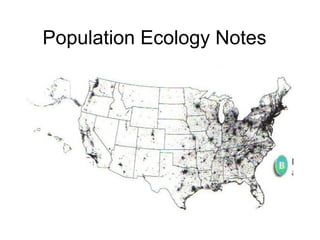Population ecology 2.07
•Download as PPT, PDF•
1 like•555 views
Report
Share
Report
Share

Recommended
More Related Content
What's hot
What's hot (20)
Similar to Population ecology 2.07
Similar to Population ecology 2.07 (20)
Complete Chapter 9:2 - Interactions Between Living Things

Complete Chapter 9:2 - Interactions Between Living Things
BIODIVERSITY KEY TO MORE VARIETY_BIO_X_Learner's Copy.pptx

BIODIVERSITY KEY TO MORE VARIETY_BIO_X_Learner's Copy.pptx
More from eziennker
More from eziennker (20)
Recently uploaded
https://app.box.com/s/z2cfx5b2yooxq1ov1wrd1dezn6af36uxBỘ LUYỆN NGHE TIẾNG ANH 8 GLOBAL SUCCESS CẢ NĂM (GỒM 12 UNITS, MỖI UNIT GỒM 3...

BỘ LUYỆN NGHE TIẾNG ANH 8 GLOBAL SUCCESS CẢ NĂM (GỒM 12 UNITS, MỖI UNIT GỒM 3...Nguyen Thanh Tu Collection
Recently uploaded (20)
BỘ LUYỆN NGHE TIẾNG ANH 8 GLOBAL SUCCESS CẢ NĂM (GỒM 12 UNITS, MỖI UNIT GỒM 3...

BỘ LUYỆN NGHE TIẾNG ANH 8 GLOBAL SUCCESS CẢ NĂM (GỒM 12 UNITS, MỖI UNIT GỒM 3...
Removal Strategy _ FEFO _ Working with Perishable Products in Odoo 17

Removal Strategy _ FEFO _ Working with Perishable Products in Odoo 17
MSc Ag Genetics & Plant Breeding: Insights from Previous Year JNKVV Entrance ...

MSc Ag Genetics & Plant Breeding: Insights from Previous Year JNKVV Entrance ...
Spring gala 2024 photo slideshow - Celebrating School-Community Partnerships

Spring gala 2024 photo slideshow - Celebrating School-Community Partnerships
Features of Video Calls in the Discuss Module in Odoo 17

Features of Video Calls in the Discuss Module in Odoo 17
Graduate Outcomes Presentation Slides - English (v3).pptx

Graduate Outcomes Presentation Slides - English (v3).pptx
Exploring Gemini AI and Integration with MuleSoft | MuleSoft Mysore Meetup #45

Exploring Gemini AI and Integration with MuleSoft | MuleSoft Mysore Meetup #45
II BIOSENSOR PRINCIPLE APPLICATIONS AND WORKING II

II BIOSENSOR PRINCIPLE APPLICATIONS AND WORKING II
Pragya Champions Chalice 2024 Prelims & Finals Q/A set, General Quiz

Pragya Champions Chalice 2024 Prelims & Finals Q/A set, General Quiz
UChicago CMSC 23320 - The Best Commit Messages of 2024

UChicago CMSC 23320 - The Best Commit Messages of 2024
REPRODUCTIVE TOXICITY STUDIE OF MALE AND FEMALEpptx

REPRODUCTIVE TOXICITY STUDIE OF MALE AND FEMALEpptx
Population ecology 2.07
- 2. Population ecology 1. Populations can be described according to certain characteristics. - size of population - spacing (how organisms are arranged in a given area) - density – how many individuals there are in a specific area
- 4. Population Density 2. The size of a population occupying an area of a specific size is called population density - the more individuals = more dense of a population - less individuals = less dense of a population
- 7. Limiting Factors 3. Limiting factor – any biotic or abiotic factor that restricts the number of individuals in a population - examples: food, temperature, living space, other resources - populations cannot grow uncontrolled forever - what affects one population can affect others living in same area
- 8. Competition 4. Competition – contest among organisms to obtain the resources they need to survive and reproduce - population density increases = increase in competition
- 10. Carrying Capacity 5. Carrying capacity – the largest number of individuals an environment can support and maintain for a long period of time - when this happens – some individual may not be able to compete, and will die or have to find another place to live
- 13. Biotic Potential 6. Biotic potential – the number of individuals each female of a population can produce under the best possible conditions - plenty of food and shelter - ideal weather, no disease or enemies - populations never reach biotic potential in the wild
- 15. 7. Niche and habitat 1. Niche – all of an organism’s relationships with its environment (both biotic and abiotic factors) a. Relationships with others, its offspring, time of day its most active, and where it finds shelter b. An organism’s “lifestyle” – how it contributes to and fits into its environment 2. Habitat – the actual place an organism lives
- 17. Questions 1. How is habitat and niche different? 2. Give some examples of things that will limit a population’s growth? 3. What is the carrying capacity of a population? 4. What are the three characteristics used to describe populations?